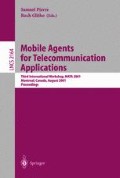Abstract
We take the position that large-scale distributed systems are better understood, at all levels, when locality is taken into account. When communication and mobility are clearly separated, it is easier to design, understand, and implement goal-directed agent programs. We present the Spider model of agents to validate our position. Systems contain two kinds of entities: spiders which represent service providers, and arms, which represent goal-directed agents. Communication, however, takes place only between an arm and the spider at which it is currently located. We present both a formal description of the model using the ambient calculus, and a Java-based implementation.
Access this chapter
Tax calculation will be finalised at checkout
Purchases are for personal use only
Preview
Unable to display preview. Download preview PDF.
References
P. S. K. Booker, R. K. Granger, E. J. Guest, S. A. Norton, J. E. Price, and H. Glaser. Software agents and their use in mobile computing. Technical Report DSSE-TR-99-5, Declarative Systems and Software Engineering Group, University of Southampton, February 1999.
G. Cabri, L. Leonardi, and F. Zambonelli. MARS: A Programmable Coordination Architecture for Mobile Agents. IEEE Internet Computing, 4(4):26–35, 2000.
Luca Cardelli and Andrew D. Gordon. Mobile ambients. In M. Nivat, editor, Proceedings of Foundations of Software Science and Computation Structures (FoSSaCS), volume 1378, pages 140–155. Springer-Verlag, Berlin, Germany, 1998.
Neeran M. Karnik and Anand R. Tripathi. Design issues in mobile-agent programming systems. IEEE Concurrency, 6(3):52–61, 1998.
Danny B. Lange. Java Aglet Application Programming Interface White Paper. IBM Tokyo Research Lab, February 1997. Online: http://www.trl.ibm.com/aglets/JAAPI-whitepaper.html.
Francesca Levi and Davide Sangiorgi. Controlling interference in ambients. In Symposium on Principles of Programming Languages, pages 352–364, 2000.
M. J. Wooldridge. The Logical Modelling of Computational Multi-Agent Systems. PhD thesis, University of Manchester, Manchester, UK, 1992.
M. J. Wooldridge and N. R. Jennings. Intelligent agents: Theory and practice. The Knowledge Engineering Review, 10(2):115–152, 1995.
Author information
Authors and Affiliations
Editor information
Editors and Affiliations
Rights and permissions
Copyright information
© 2001 Springer-Verlag Berlin Heidelberg
About this paper
Cite this paper
Huang, F.Y., Skillicorn, D.B. (2001). The Spider Model of Agents. In: Pierre, S., Glitho, R. (eds) Mobile Agents for Telecommunication Applications. MATA 2001. Lecture Notes in Computer Science, vol 2164. Springer, Berlin, Heidelberg. https://doi.org/10.1007/3-540-44651-6_20
Download citation
DOI: https://doi.org/10.1007/3-540-44651-6_20
Published:
Publisher Name: Springer, Berlin, Heidelberg
Print ISBN: 978-3-540-42460-4
Online ISBN: 978-3-540-44651-4
eBook Packages: Springer Book Archive

